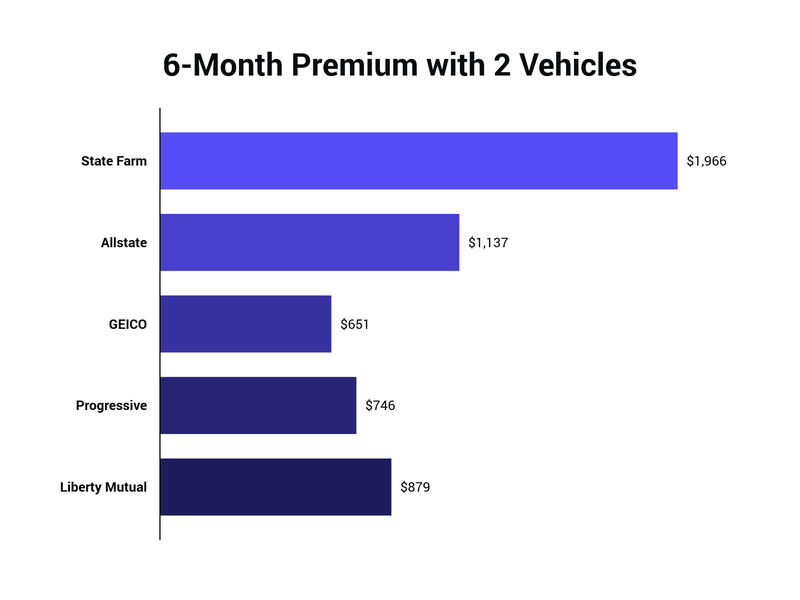Beyond the basics of car insurance, a broader perspective on financial security is essential. This exploration delves into comprehensive financial protection, encompassing various insurance products, risk management strategies, and investment options. Understanding how these elements interrelate is crucial for navigating life’s financial complexities.
We’ll examine how different types of insurance complement car insurance, offering a holistic approach to safeguarding your financial well-being. We’ll also look at proactive risk management, exploring diversification strategies and potential mitigation steps. The importance of personal financial planning, encompassing budgeting, debt management, and emergency funds, will also be discussed.
Understanding Comprehensive Financial Protection
Beyond the immediate concerns of car repairs and potential liability, comprehensive financial protection encompasses a wider spectrum of security and peace of mind. It extends beyond the confines of a single vehicle and addresses various life situations requiring financial preparedness. This goes far beyond just protecting your car; it’s about safeguarding your overall financial well-being.
Comprehensive financial protection is a multifaceted approach to managing financial risks. It involves understanding and mitigating various vulnerabilities, from unexpected medical expenses to the uncertainties of job loss. By proactively addressing these potential challenges, individuals and families can build a more resilient financial future.
Types of Insurance Products
A range of insurance products form the foundation of comprehensive financial protection. These products address diverse needs, ensuring that individuals and families are prepared for unforeseen circumstances. These products often complement car insurance, offering broader coverage and peace of mind.
- Health Insurance provides coverage for medical expenses, including hospitalization, surgeries, and doctor visits. It’s crucial for managing the substantial costs associated with illness or injury. Many employers offer health insurance plans, but individual policies can provide additional flexibility and coverage options.
- Life Insurance offers financial support to beneficiaries in the event of the policyholder’s death. This can be crucial for providing financial security for dependents, paying off debts, or covering funeral expenses. Term life insurance is often chosen for its affordability, while whole life insurance offers both death benefits and cash value growth.
- Disability Insurance protects against lost income due to a disability that prevents an individual from working. This is vital for maintaining a standard of living during periods of reduced or no income. Disability insurance can replace a portion of lost wages, allowing individuals to maintain essential expenses and financial obligations.
- Homeowners Insurance protects against financial loss from damage to or destruction of a home. It typically covers property damage from perils such as fire, storms, and vandalism. Homeowners insurance also often includes liability coverage, protecting the homeowner against claims for injuries to others occurring on their property.
- Renters Insurance offers protection against financial loss from damage to or destruction of personal belongings in a rental property. It’s a crucial safety net for individuals living in rented spaces, covering items such as furniture, clothing, and electronics.
Complementing Car Insurance
Comprehensive financial protection doesn’t replace car insurance; it enhances it. Car insurance addresses immediate vehicle-related risks, but comprehensive protection offers a wider safety net for various life situations. Both work together to provide a holistic approach to risk management.
Importance Across Life Stages
The need for comprehensive financial protection evolves throughout life. Different life stages present varying levels of risk and financial responsibility. Understanding these stages allows for tailored financial protection strategies.
- Early Adulthood often involves establishing careers and building personal finances. Comprehensive protection can include health insurance, disability insurance, and potentially life insurance.
- Mid-life typically entails greater financial responsibilities like mortgages and family expenses. Comprehensive protection may include homeowners insurance, life insurance, and potentially long-term care insurance.
- Retirement necessitates protection against potential long-term care needs and income gaps. Long-term care insurance and possibly supplemental retirement income insurance may be critical.
Comparing Financial Protection Products
The following table offers a comparative overview of different financial protection products. It highlights key features, benefits, and potential costs.
| Product | Key Features | Benefits | Potential Costs |
|---|---|---|---|
| Health Insurance | Covers medical expenses | Maintains health and well-being | Premiums based on plan type and coverage |
| Life Insurance | Provides financial support to beneficiaries | Secures financial future for dependents | Premiums based on age, health, and coverage amount |
| Disability Insurance | Replaces lost income due to disability | Maintains financial stability during disability | Premiums based on age, health, and coverage amount |
| Homeowners Insurance | Protects home from damage | Covers property and liability | Premiums based on home value, location, and coverage |
| Renters Insurance | Protects personal belongings | Covers belongings in rental property | Premiums based on rental unit and coverage |
Exploring Additional Risk Management Strategies

Beyond car insurance, a comprehensive approach to financial protection necessitates considering various risk management strategies. This involves proactively mitigating potential financial vulnerabilities beyond the scope of traditional vehicle coverage. Effective risk management extends to numerous aspects of personal and financial life, encompassing investments, health, and even unforeseen circumstances.
Diversification is a key element in building resilience against financial shocks. A robust financial plan should incorporate diverse strategies to safeguard assets and income streams. This approach acknowledges the unpredictable nature of life events and the potential for multiple risks to materialize simultaneously.
Diversification of Financial Assets
Diversifying financial assets is crucial for mitigating risk. Holding a variety of investments, including stocks, bonds, and real estate, can help balance potential losses in one area with gains in another. This approach minimizes the impact of market fluctuations or sector-specific downturns on overall portfolio performance. Historical data demonstrates that diversified portfolios often outperform those concentrated in a single asset class. For example, a portfolio invested in both stocks and bonds will generally exhibit lower volatility than a portfolio solely invested in stocks.
Proactive Risk Mitigation Strategies
Taking proactive steps to mitigate risks beyond car insurance is essential for long-term financial well-being. These steps often involve a proactive assessment of personal circumstances and developing strategies to address potential vulnerabilities. Examples include creating an emergency fund, developing a comprehensive budget, and considering various insurance options beyond car insurance.
- Emergency Fund Creation: Establishing an emergency fund is crucial for covering unexpected expenses, such as job loss, medical emergencies, or home repairs. This fund provides a safety net during periods of financial hardship. A well-defined emergency fund acts as a buffer against unforeseen circumstances, reducing the likelihood of incurring significant debt or depleting savings. Aim for at least 3-6 months of living expenses.
- Comprehensive Budget Planning: A detailed budget helps individuals track income and expenses, identifying areas where spending can be reduced or adjusted. Understanding financial inflows and outflows allows for better control over finances and facilitates informed financial decisions. By creating a budget, one can allocate resources more effectively, prioritizing essential needs and potentially freeing up funds for savings and investments.
- Health Insurance and Disability Coverage: Comprehensive health insurance and disability coverage protect against significant medical expenses. These provisions can safeguard against substantial financial burdens associated with illnesses or injuries. Health insurance and disability coverage can significantly reduce the impact of unforeseen health events on an individual’s financial stability.
- Property Insurance: Property insurance protects against losses from damage or destruction to assets such as homes, apartments, or other real estate. This insurance provides financial security against unexpected events that can cause significant financial strain. Ensuring sufficient property insurance coverage is crucial to protect against significant financial losses due to unexpected events.
Comparing Risk Management Techniques
Different risk management techniques vary in their effectiveness depending on individual circumstances and the specific risks being addressed. For instance, diversification in investment portfolios is a valuable strategy for mitigating market risk, while an emergency fund offers protection against unforeseen financial shocks. Assessing the suitability of each technique requires careful consideration of personal risk tolerance, financial goals, and potential losses.
Potential Risks and Mitigation Strategies
| Potential Risk | Mitigation Strategy |
|---|---|
| Job Loss | Develop a comprehensive resume, enhance professional skills, build a network of contacts, and maintain an emergency fund. |
| Major Illness | Purchase comprehensive health insurance, explore preventative healthcare options, and maintain healthy lifestyle habits. |
| Home Damage/Loss | Acquire property insurance, regularly maintain the property, and explore home security measures. |
| Investment Losses | Diversify investment portfolio, conduct thorough research before investing, and seek professional financial advice. |
Analyzing Investment Options for Financial Growth
Investment strategies play a crucial role in supplementing comprehensive financial protection. Beyond simply saving, strategic investment can significantly bolster your financial security and generate returns that contribute to long-term financial goals. This section explores various investment options, their inherent risks and rewards, and the importance of aligning investment strategies with a broader financial plan.
Investment strategies are not merely about maximizing returns; they are about thoughtfully allocating capital to achieve specific financial objectives while managing potential risks. Understanding the interplay between investment choices and overall financial protection is key to developing a robust and resilient financial strategy.
Investment Options for Building Financial Security
Diversification across various investment vehicles is a cornerstone of sound financial planning. A diversified portfolio helps mitigate risk by spreading investments across different asset classes, each with its own inherent characteristics and potential for returns.
- Stocks: Stocks represent ownership in a company. Historically, stocks have offered the potential for higher returns compared to other investment options, but they also carry higher risk due to fluctuations in company performance and market conditions. For example, successful tech companies like Apple and Microsoft have delivered significant returns over the years, while others have underperformed or even gone bankrupt. Investors should carefully consider their risk tolerance and investment horizon when allocating capital to stocks.
- Bonds: Bonds are essentially loans to a government or corporation. They typically offer lower returns than stocks but are considered less risky, providing a degree of stability in a portfolio. Government bonds, for instance, are often viewed as a safer investment than corporate bonds, which carry greater risk. Investors seeking a more conservative approach may find bonds suitable for a portion of their portfolio.
- Mutual Funds: Mutual funds pool money from multiple investors to invest in a diversified portfolio of stocks, bonds, or other assets. This diversification helps mitigate risk and allows investors to gain access to a wider range of investments without needing to manage individual assets. A well-managed mutual fund can provide professional investment management for a relatively low cost.
- Real Estate: Real estate investments, such as residential or commercial properties, can offer substantial returns, potentially outpacing other asset classes in certain market conditions. However, real estate investments often involve higher transaction costs and can require significant capital. Furthermore, property values can fluctuate, and maintenance costs can be substantial.
Potential Risks and Rewards of Different Investments
Each investment option comes with its own set of potential risks and rewards. Understanding these is crucial for making informed investment decisions aligned with individual financial goals and risk tolerance.
- Stocks: Stocks can offer substantial returns, but their value is subject to market fluctuations, impacting the potential for losses. Historically, stock market crashes have occurred, highlighting the importance of diversification and long-term investment strategies.
- Bonds: Bonds generally carry lower risk than stocks, but their returns are often lower as well. Interest rate changes can affect bond prices, potentially leading to losses. For example, rising interest rates can decrease the value of existing bonds.
- Mutual Funds: While mutual funds offer diversification, their performance is dependent on the performance of the underlying assets. Fund managers’ decisions can also impact returns, making careful research and due diligence necessary.
- Real Estate: Real estate investments can provide substantial returns, but they come with inherent risks like property value fluctuations, market downturns, and maintenance expenses. The costs and time commitment associated with real estate investments should be carefully considered.
Financial Planning and Investment Strategies
A well-defined financial plan is essential for aligning investment strategies with overall financial objectives. A financial plan should consider factors such as income, expenses, debt, and future goals. It provides a roadmap for achieving long-term financial security.
Illustrative Investment Vehicle Potential Returns
The following table provides a general overview of potential returns for different investment vehicles. These are estimates and do not guarantee future performance. Actual returns will vary depending on market conditions and individual circumstances.
| Investment Vehicle | Potential Return (Annualized, approximate) | Risk Level |
|---|---|---|
| Stocks | 7-12% | High |
| Bonds | 3-6% | Low |
| Mutual Funds | 5-8% | Moderate |
| Real Estate | 5-10% | Moderate to High |
Examining Legal and Regulatory Frameworks

Navigating the financial world involves understanding the legal and regulatory landscape. These frameworks provide a crucial structure for consumers and businesses alike, ensuring fairness, transparency, and accountability. Compliance with these regulations is essential for protecting investments and avoiding potential legal issues.
The legal and regulatory environment surrounding financial products beyond car insurance is complex and multifaceted. Regulations are designed to safeguard consumers, prevent fraud, and promote market stability. Understanding these regulations is vital for making informed financial decisions and mitigating potential risks.
Legal Aspects of Investment Products
Investment products, including stocks, bonds, mutual funds, and exchange-traded funds (ETFs), are subject to various legal and regulatory requirements. These regulations aim to protect investors from fraudulent schemes and ensure fair market practices. For example, the Securities Act of 1933 and the Securities Exchange Act of 1934, along with related regulations from the Securities and Exchange Commission (SEC), govern the issuance and trading of securities. These laws dictate how companies can raise capital, how investors can be informed about potential risks, and what reporting obligations companies have.
Regulatory Oversight of Financial Institutions
Financial institutions offering various financial products are subject to stringent oversight by governmental agencies. These institutions, including banks, credit unions, and insurance companies, are regulated to maintain financial stability and protect consumers. For instance, the Federal Reserve System (the Fed) plays a critical role in regulating banks and maintaining the stability of the financial system. Similarly, the Consumer Financial Protection Bureau (CFPB) oversees consumer financial products and services, addressing issues such as predatory lending and unfair practices.
Consumer Protection Laws
Consumer protection laws are designed to safeguard consumers from unfair or deceptive practices in the financial marketplace. These laws cover various aspects of financial transactions, from credit card agreements to mortgage applications. For instance, the Truth in Lending Act (TILA) mandates clear and accurate disclosure of loan terms and conditions, enabling consumers to make informed decisions. The Fair Credit Reporting Act (FCRA) regulates how credit bureaus collect, use, and share consumer information. These laws aim to create a more equitable and transparent financial environment.
Table of Key Legal and Regulatory Requirements
| Financial Product | Key Legal/Regulatory Requirements |
|---|---|
| Stocks | Registration with the SEC, disclosure requirements, insider trading laws. |
| Bonds | Registration requirements, disclosure of bond terms, credit rating agencies’ role. |
| Mutual Funds | Regulation of fund managers, disclosure of fund holdings, investment objectives. |
| ETFs | Registration requirements, transparency of holdings, trading regulations. |
| Mortgages | Truth in Lending Act (TILA), Real Estate Settlement Procedures Act (RESPA), mortgage fraud laws. |
| Credit Cards | Truth in Lending Act (TILA), Fair Credit Billing Act, credit card industry regulations. |
| Insurance Policies | State insurance regulations, consumer protection laws, claims handling procedures. |
Analyzing Personal Financial Planning Strategies

Personal financial planning is a crucial component of comprehensive financial protection. It encompasses a wide range of strategies, from budgeting and saving to managing debt and building emergency funds. A well-structured financial plan can significantly reduce financial risks and enhance overall financial well-being. It complements other financial protections, such as insurance and investment strategies, by providing a framework for achieving specific financial goals.
A robust personal financial plan is not merely a collection of techniques; it’s a roadmap tailored to individual circumstances and aspirations. It guides decision-making related to income, expenses, investments, and debt management, ultimately leading to greater financial security. A well-defined plan allows individuals to proactively address potential financial challenges, fostering peace of mind and enabling them to pursue their life goals.
Budgeting and Saving for Financial Protection
Effective budgeting is the cornerstone of sound financial planning. It involves tracking income and expenses to understand spending patterns and identify areas for potential savings. A well-designed budget allows individuals to allocate resources effectively, prioritizing essential needs and maximizing opportunities for growth. Regular saving is essential for building financial security. Consistent savings, even small amounts, can accumulate significantly over time, providing a safety net for unexpected expenses and enabling the achievement of long-term financial goals.
Debt Management Strategies
Managing debt effectively is vital for maintaining financial stability. Strategies for managing debt include creating a debt repayment plan, prioritizing high-interest debts, and exploring debt consolidation options. A structured approach to debt repayment, whether through the snowball or avalanche method, can significantly reduce the overall debt burden and associated interest payments.
Importance of Emergency Funds
Establishing an emergency fund is crucial for mitigating financial risks. An emergency fund serves as a safety net, providing a financial cushion to cover unexpected expenses such as medical emergencies, job loss, or car repairs. This fund acts as a buffer against unforeseen circumstances, preventing financial hardship and allowing individuals to maintain their financial stability. A commonly recommended rule of thumb is to aim for 3-6 months of living expenses in an emergency fund.
Creating a Comprehensive Financial Plan
Developing a comprehensive financial plan involves several key steps. This includes assessing current financial status, setting realistic financial goals, and creating a detailed plan for achieving those goals. Regular review and adjustments to the plan are essential, as circumstances change over time. The plan should consider factors like retirement savings, education funding, and estate planning, providing a comprehensive framework for financial security. A financial advisor can offer guidance and support in developing and implementing a comprehensive plan.
Complementary Strategies for Financial Protection
Personal financial planning strategies, including budgeting, saving, debt management, and emergency funds, complement other financial protections, such as insurance and investment strategies. A comprehensive approach that integrates these strategies creates a well-rounded financial safety net, allowing individuals to navigate various life stages and achieve their financial objectives. A comprehensive plan accounts for potential risks and uncertainties, enabling individuals to adapt and thrive in changing circumstances.
Illustrative Case Studies of Comprehensive Protection
Comprehensive financial protection isn’t just about acquiring various products; it’s about strategically integrating them to address diverse life situations and potential risks. Case studies provide invaluable insights into how individuals can effectively utilize these strategies for long-term financial well-being. By examining successful implementations, we can gain a clearer understanding of the practical applications and potential outcomes of well-designed protection plans.
Successful Utilization of Comprehensive Strategies
Amelia, a 35-year-old small business owner, recognized the importance of comprehensive financial protection early in her career. She implemented a robust plan encompassing life insurance, disability insurance, and business interruption coverage. Her comprehensive strategy included a well-defined emergency fund, which allowed her to weather a challenging period during which her business faced unexpected disruptions. This adaptability and foresight demonstrated how comprehensive protection can safeguard both personal and professional endeavors.
Integrating Different Financial Protection Products
Consider the case of David, a 40-year-old family man. David secured a combination of life insurance, long-term care insurance, and a comprehensive health insurance policy. This integrated approach protected his family’s financial future in the event of a critical illness or disability, ensuring their well-being. The integration of different policies provided a layered approach to financial security, reducing the impact of unforeseen circumstances.
Adapting Strategies to Life Events
Financial protection strategies are not static; they need to adapt to significant life changes. Sarah, a 25-year-old recent graduate, initially focused on building an emergency fund and securing health insurance. As she transitioned to a stable job and started a family, she proactively adjusted her plan by adding life insurance and disability insurance. This demonstrates the crucial role of dynamic planning to meet evolving needs.
Long-Term Impact of a Well-Structured Plan
Mark, a 50-year-old retired individual, benefited significantly from his well-structured financial protection plan established decades earlier. The combination of retirement savings, a robust investment portfolio, and carefully selected insurance policies provided him with a stable and secure retirement. This demonstrates the long-term financial security achievable through proactive planning.
Key Lessons Learned from Case Studies
| Case Study | Key Lessons |
|---|---|
| Amelia | Proactive planning for both personal and business risks is crucial. A well-defined emergency fund can be a significant buffer against unexpected disruptions. |
| David | A layered approach to financial protection, integrating various products, provides a more comprehensive safety net. |
| Sarah | Financial protection plans should be dynamic and adaptable to life changes, ensuring ongoing security. |
| Mark | A well-structured long-term plan, including savings, investments, and insurance, can guarantee financial stability throughout different life stages. |
Illustrating the Importance of Insurance Beyond Car Insurance

Comprehensive financial protection extends far beyond the confines of traditional car insurance. While car insurance safeguards against vehicle-related risks, a broader perspective encompasses a wider range of potential financial vulnerabilities. This broader approach is vital for navigating life’s unpredictable events and mitigating the impact of unforeseen circumstances.
Protecting your financial well-being requires considering a spectrum of potential risks, from health issues and job loss to property damage and legal liabilities. Insurance products tailored to these specific needs provide a crucial safety net, allowing individuals and families to manage financial burdens and maintain stability during challenging times.
Scenarios Where Traditional Car Insurance Is Insufficient
Traditional car insurance primarily addresses damages related to accidents or incidents involving a vehicle. However, it often fails to cover broader financial risks. For example, if a car accident leads to significant medical expenses for individuals involved, car insurance might not fully compensate for those costs. Similarly, if a vehicle is damaged beyond repair due to an unforeseen event (like a natural disaster), the coverage might not adequately address the financial consequences. Additionally, car insurance typically doesn’t cover losses resulting from liabilities beyond the accident itself, such as lawsuits or legal proceedings.
Situations Requiring Broader Financial Protection
Beyond the scope of car insurance, numerous situations necessitate comprehensive financial protection. Unexpected health issues, job loss, or significant property damage can quickly deplete savings and create insurmountable financial burdens. A robust financial protection strategy, encompassing various insurance products, is crucial to mitigate these risks. The following examples demonstrate how these broader insurance products can provide a safety net:
Examples Demonstrating Benefits of Encompassing Financial Products
Consider a scenario where a homeowner experiences a fire that destroys their property. Traditional homeowners insurance would help cover the rebuilding costs. However, if the homeowner had a comprehensive financial plan that included disability insurance, the income replacement would help mitigate the financial disruption during the rebuilding process. Further, life insurance could provide financial support to the family in the event of the homeowner’s death. In another example, a business owner faces a lawsuit due to a product defect. Liability insurance would help cover legal costs and potential damages, safeguarding the business’s financial future. These examples highlight the critical role of various insurance products in mitigating financial risks beyond the scope of traditional car insurance.
Illustrative Scenarios Preventing Financial Hardship
Insurance products can prevent significant financial hardship in numerous scenarios. A young professional with a mortgage and young children who experiences a debilitating illness might find themselves facing overwhelming medical expenses and lost income. Health insurance, disability insurance, and life insurance can mitigate the financial strain by covering medical costs, lost income, and providing financial support to dependents. A business owner facing a period of decreased sales and increased operating costs might face a critical cash flow issue. Business interruption insurance would help compensate for lost revenue, allowing the business to continue operations during the challenging period. These scenarios showcase how insurance protects against unexpected events, thereby preventing significant financial hardship.
Table Illustrating Life Events and Financial Protection Needs
| Life Event | Financial Protection Needed |
|---|---|
| Unexpected Illness/Injury | Health insurance, disability insurance |
| Job Loss | Disability insurance, unemployment benefits, savings/emergency fund |
| Home Damage/Loss | Homeowners insurance, flood insurance, renter’s insurance |
| Business Disruption | Business interruption insurance, liability insurance |
| Death of a Loved One | Life insurance, estate planning |
This table demonstrates how various life events necessitate different levels of financial protection. Tailoring a comprehensive financial protection plan to individual circumstances is essential to mitigate the financial impact of unforeseen events.
Illustrating Strategies for Building Financial Security
Building financial security is a multifaceted process requiring careful planning and consistent effort. It’s not a destination but a journey that involves understanding your current financial situation, setting realistic goals, and consistently implementing strategies to achieve those goals. This process encompasses more than just saving; it involves prudent spending habits, smart investment choices, and proactive risk management.
A strong foundation for financial security involves a combination of factors, including building an emergency fund, diversifying income streams, and understanding and mitigating potential financial risks. By actively managing your finances, you can increase your capacity to weather unexpected events and achieve long-term financial stability.
Diversifying Income Streams
Diversifying income streams involves exploring options beyond a primary source of income. This can enhance resilience against unforeseen circumstances and boost earning potential.
- Part-time work or side hustles: Engaging in supplemental work, such as freelance work, online tutoring, or selling goods online, can provide additional income streams.
- Investing in dividend-paying stocks or real estate: These investments can generate passive income over time. The key is to understand the risks and potential returns involved in such ventures. For example, real estate investment trusts (REITs) offer a way to earn dividends from property ownership, while dividend-paying stocks provide periodic income based on company profitability.
- Developing a skillset in high demand: Acquiring skills in high-demand sectors can lead to better employment opportunities and potentially higher salaries, which can strengthen your financial security.
Creating an Emergency Fund
An emergency fund acts as a safety net against unexpected expenses. It’s crucial for protecting your financial well-being.
- Establish a savings goal: Aim for three to six months of living expenses in your emergency fund. This provides a buffer against job loss, medical emergencies, or major repairs.
- Automate savings: Set up automatic transfers from your checking account to your savings account to make saving a consistent habit.
- Prioritize savings over spending: Even small, regular contributions can significantly increase the size of your emergency fund over time. Consider cutting unnecessary expenses to free up funds for savings.
Implementing Long-Term Financial Planning
Long-term financial planning involves strategies to secure your future. This includes retirement planning and estate planning.
- Retirement planning: Start saving early, and consider diversifying your investments to mitigate risk. Contribute to retirement accounts such as 401(k)s or IRAs, and adjust your investment strategy as your circumstances change.
- Estate planning: Creating a will and designating beneficiaries ensures that your assets are distributed according to your wishes after your passing. This protects your loved ones and ensures a smooth transition of your estate.
- Reviewing and adjusting your plan: Regularly review your financial plan and adjust it based on changes in your life, such as marriage, childbirth, or career changes.
Comparing Financial Security Building Strategies
| Strategy | Description | Pros | Cons |
|---|---|---|---|
| Emergency Fund | Building a savings account for unexpected expenses. | Provides financial security, reduces stress. | Requires discipline, may not always be sufficient. |
| Diversifying Income | Exploring multiple income streams. | Increases earning potential, reduces reliance on one source. | Requires effort and time to establish new income streams. |
| Long-Term Planning | Strategies for retirement and estate planning. | Secures future, protects loved ones. | Requires commitment, may not be immediately profitable. |
Closing Summary

In conclusion, safeguarding your financial future extends far beyond the scope of car insurance. This comprehensive guide has illuminated the diverse aspects of financial protection, risk management, and investment strategies. By understanding these concepts and implementing tailored strategies, you can build a robust financial foundation for a secure and prosperous future.

